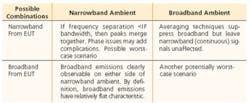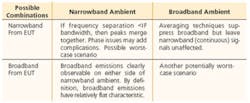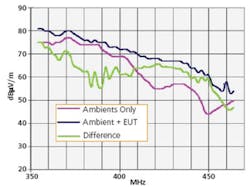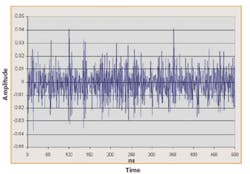We live in a jumble of man-made noise that threatens to overwhelm any measurements we want to take in unscreened environments.
The effectiveness of ambient or background noise cancellation has long been debated. However, there is little published evidence to justify the claims made by either side of the debate. In an attempt to settle the question, we performed some simple experiments with unexpected and surprisingly clear-cut conclusions.
Cancellation may be used both for identification and measurement. Identification techniques locate EUT emissions frequencies and source locations in the presence of high ambients. In both cases, the use of near-field probes provides a very effective answer. If you have attempted to locate emissions reliably in the far field without some kind of ambient cancellation, you will know how frustrating this can be.
Measurement techniques go one step further and potentially are capable of measuring the EUT emissions levels with some degree of accuracy. Two approaches to the problem of ambient cancellation are currently available from EMC test-equipment manufacturers:
1. A difference technique measures just the ambient first, takes a second measurement with the EUT switched on, and uses software to subtract the first from the second measurement.
2. A twin-channel analyzer provides two cancellation possibilities:
a. Correlation of a near-field probe input with the far-field antenna input, assuming that any significant emissions must be detectable in the EUT near field and that near-field probes are blind to ambient signals.
b. Use of two far-field antennas, one at a significant distance from the test site, and extracting the EUT emissions via difference techniques.
Each technique has its pros and cons. For instance, technique 1 suffers in the presence of a fluctuating ambient but has the advantage of potentially being accessible to any standard EMC receiver or analyzer.
Both options in technique 2 require the use of a special twin-channel EMC analyzer, and 2a exposes as false the assumption that near-field probes are immune to ambient. In reality, strong ambients are induced into any cabling associated with the EUT and reradiated as a near-field signal. Both 1 and 2b depend on the validity of the difference technique.
The validity of using some kind of difference trace to calculate the emissions levels from an EUT in the presence of ambient is based on the assumption that the field strength will increase when switching on a second source with a frequency within the analyzer�s resolution bandwidth (RBW). It is well known that the ground-reflected signal combines with the direct signal on a standard site to increase the field strength by almost 6 dB, which on a linear scale is a �2 factor. This is reasonable given that the two signals will be of similar strength.
Of course, the signals in this case are strictly coherent since they are from the same source and in phase. Changing the phase relationship, such as varying the height of the antenna, will completely undo this result.
So, phase matters. But does it matter when we are considering an EUT emission and an ambient signal? This was one of the aspects for investigation in the following experiments.
The Experiments
We created a known ambient and a known EUT signal and studied how the field strength measured by an EMC analyzer was affected when both sources were on together. First, we considered the type of signals to create. Broadband and narrowband signals are common, both from EUTs and the ambient. We should not assume that any cancellation technique will work equally well or badly for all combinations of these two signal types.
According to Table 1, it seems that the toughest challenge for any cancellation technique is when both the EUT and the ambient signals are of the same type. For that reason, our experiments modeled these two situations.
The Narrowband Experiment
The test involved the use of two emissions reference sources (ERSs), one to simulate the background ambient level and the other to simulate an EUT. These are comb generators, essentially narrowband sources with continuous time-domain emissions. They radiate a series of frequencies with 2-MHz spacing. The outputs of the two units are matched within 40 ppm, well within the analyzer RBW, presenting an almost worst-case scenario. The close frequency matching eliminates the use of frequency discrimination to separate the two narrowband signals, and the steady-state nature of both prevents the use of averaging techniques.
The ERSs actually give very similar radiated output levels, but they were located in different positions in the laboratory so the signals received from each at the measurement antenna were different. The difference is due to the change in site attenuation at the two locations.
The 350-MHz to 450-MHz frequency range was chosen because this range was relatively free of other background signals. Each ERS initially was measured separately. The one that gave the lowest levels as measured by the antenna was chosen as unit A. The other, unit B, represented the ambient.
Figure 1a shows the ambient-only spectrum generated by unit B alone and the increased level when the EUT is switched on so that units A and B are on together. It also includes the calculated difference trace. This is not the simple difference of A and B but one that takes the log scaling into account. This is the estimated level of the emissions from the EUT.
Figure 1b compares the estimated level and the actual level of emissions from the EUT. The difference technique has delivered a remarkably good measurement of the actual emissions level. At 380 MHz, the difference trace is within 4 dB of the actual even though the EUT is more than 15 dB below the ambient level, showing that this technique can be remarkably effective.
Phase
This experiment has used two independent sources so the signals are incoherent. Incoherent signals are not phase locked. This will be true when dealing with EMC applications when an ambient signal is to be cancelled. A phase relationship will exist between the EUT and each ambient source, causing the combined field to fluctuate at the difference frequency. So a 253-, 456-, and 589-Hz ambient and a 253-, 456-, and 800-Hz EUT signal will mix to create a 211-Hz resultant or fluctuation frequency.
When using a quasipeak (QP) detector with a band C time constant of 550 ms, these fluctuations will not affect the resultant. Indeed, for any phase effect to be observed, the two frequencies must be within a couple of hertz. That�s possible but highly unlikely, especially over any meaningful period of time.
Ambient Variation
The only problem that would affect the results is an unstable ambient. We routinely use a technique that stabilizes the ambient by using an averaging or maximum hold technique when acquiring both the ambient trace and the ambient + EUT trace. Typically, using either technique on a set of eight scans generates a stable result.
The difference trace then produces a relatively clean measure of the emissions from the EUT. Naturally, there often is some rogue transmission that just happens to appear as EUT emissions, but simple common-sense investigations soon show these do not originate from the EUT.
The Broadband Experiment
The same procedure as used for the narrowband test was repeated, this time with two York Electromagnetics Comparison Noise Emitters (CNE). These generators use high-bandwidth impulsive noise sources to produce a relatively flat, broadband output spectrum. Again, the emissions from each were plotted separately. Plots were taken with first one then both sources switched on.
The results showed that the difference subtraction technique failed to provide even a rough estimate of the levels from the EUT. Clearly, the signals were not interacting in the same way as the narrowband sources had done.
To improve the result, the difference was recalculated based on voltage rather than power. Although better, there still are wide inconsistencies. Use of the QP and average detectors did not significantly improve matters.
In an attempt to resolve why the two signals apparently did not sum together, the signals from the receiving antenna were plotted in the time domain. Figures 2a and 2b were acquired on a 500-MHz DSO. The time axis is in nanoseconds, and the vertical scale is identical for both plots.
Figure 2a shows the signal from the antenna with one source switched on. A plot of the other source operating independently is similar. The impulsive nature of these sources is immediately evident. Fourier analysis implies that to achieve a relatively flat spectrum in the frequency domain, the time domain must have a transient nature. The signals are completely random in nature as expected from noise sources.
Figure 2b shows the two sources radiating simultaneously. The frequency of the impulsive spikes has doubled, but the peak levels are unaffected. Accordingly, a peak detector generally will maintain the same level as the strongest source, unaffected by the presence of any source with a lower level of impulsive peaks. This assumes that the spectral bands of the two sources overlap. If this were not the case, identification of the EUT emissions would be simple.
A calculation to indicate the level of the signal in each waveform was undertaken by summing the absolute values of all the DSO samples in each frame, which shows that the expected increase in the signal does occur in the time domain.
Initially, we thought that the use of an average or QP detector would improve the performance of the difference technique. This was not observed because the output of these CISPR16-type detectors is dependent on the repetition rate of the incoming impulses.
Time constants within these detectors are such that for repetition rates above 10 kHz the detector output will be equal to that of a peak detector. In other words, once above 10 kHz, increasing the repetition rate will have no effect. A study of the waveforms shows that significant impulses occur at a median interval of approximately 300 ns, equivalent to a repetition rate of 3.3 MHz and well above 10 kHz.
The analysis holds true for the CNE noise sources we used. Other noise sources with different characteristics may behave differently. For instance, some sources of real-world noise are caused by AC frequency switching devices such as phase-angle power controllers. These have an impulse repetition rate of 100 Hz or 120 Hz.
Doubling the rate by introducing a second source would increase the QP level by some 3 dB and the average level by approximately 6 dB. This suggests that a difference technique would work, but factors such as relative timing or relative phase angles and duty cycle may influence the results.
Coping With the Real World
In real-world situations where both the background and the EUT emissions are broadband with overlapping spectra and the nature of the noise sources is unknown, the use of any difference technique should be avoided. In practice, however, a modified difference trace technique has been successful in detecting the general spectrum of broadband emissions from an EUT, even in situations of high-level ambient.
This modified technique involves the use of an average scanning technique coupled with a peak detector:
� With the EUT off, free run the analyzer and calculate the average level at each frequency point over several sweeps.
� When the resultant has stabilized, cease scanning and store this as the background trace.
� Switch the EUT on and repeat the average scanning process until the resultant has stabilized.
� Plot the difference between the two results.
Although not recommended for accurate measurements, this technique gives an excellent estimation of the EUT emissions for precompliance purposes.
Summary
Where the ambient and EUT sources are of mixed narrowband and broadband types, the measurement of EUT emissions generally is possible with common-sense judgment. The difference trace technique works well in the narrowband/narrowband situation, provided that the background is stable. However, additional techniques are available that have proved very effective in coping with unstable backgrounds.
When both ambient and EUT emissions are broadband, measurements become unreliable, and the difference technique fails to provide an approximation of EUT levels. However, the nature of the sources used in the experiment may not be typical of the real world. Experience has consistently shown that the difference trace technique provides a useful guide for EUT emissions even in worst-case situations. This probably is due to the lower repetition rates that typically cause the real broadband emissions.
About the Author
David Mawdsley is the founder and managing director of Laplace Instruments. Mr. Mawdsley obtained an honors degree at London University before working for Rolls Royce (Aero Engines) as an assistant engineer and later for Data Acquisition Ltd., specializing in the problems associated with vibration analysis in helicopters. Laplace Instruments, 3B, Middlebrook Way, Cromer, Norfolk NR27 9JR, U.K., 011 44 12 63 51 51 60, e-mail: [email protected]
January 2005





